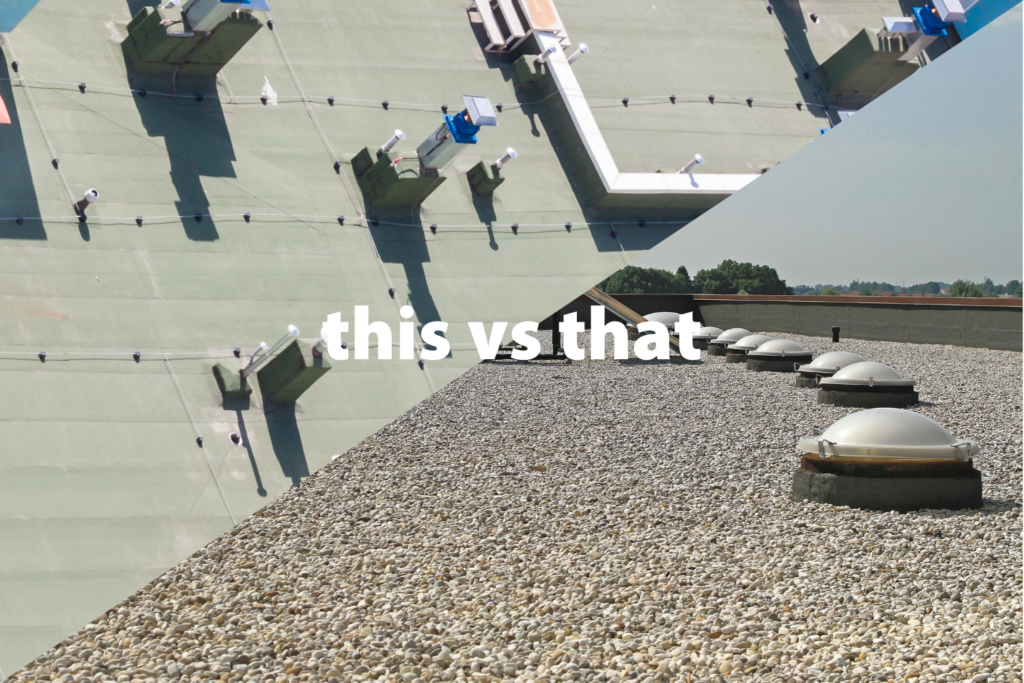
This vs. that: ballasted versus mechanically-fastened roof systems
Comparing and contrasting ballasted vs. mechanically-fastened roofs
As you consider your options for your next design-build project, you’ll want to decide on the right roofing system/assembly to fit your commercial construction project. Roofing systems vary, and each has its strong points and drawbacks. Here’s a comparison of two common commercial roofing systems: ballasted vs. mechanically-fastened roof systems.
What is a ballasted roof system?
With a ballasted roofing system, insulation sheets are loosely laid on the roof decking. Sheets of EPDM roof membrane (ethylene propylene diene terpolymer), a synthetic rubber membrane, are then laid to cover the insulation. Adjoining sheets are overlapped and joined with seam tape, after which the perimeter of the roof and all penetrations are flashed/sealed according to the technical specifications. Then the entire roof is weighed down using river-washed ballast.
What is a mechanically-fastened roof system?
With a mechanically-fastened roof system, insulation sheets are laid out on the roof system and mechanically fastened with insulation plates and fasteners to the roof decking. Sheets of EPDM roof membrane are then laid out to cover the insulation. Adjoining sheets are then overlapped, affixed with seam tape and mechanically fastened with seam plates and fasteners. The perimeter of the roof and all penetrations are then flashed/sealed according to the technical specifications.
Pros and cons of ballasted roof systems:
- Ballasted roof systems are less expensive than mechanically-fastened roof systems.
- EPS insulation (expanded polystyrene insulation) can be used in ballasted roof systems instead of poly-iso insulation, which is less expensive and has a shorter lead time.
- Ballasted roof systems are best suited for large, open roofs with fewer roof penetrations.
- Installation is faster than on mechanically-fastened roof systems.
- The structural roof system must be upsized to accommodate the weight of the roof ballast, which adds cost to the structural roof system.
- A ballasted roofing system has fewer seams due to larger EPDM membrane sheets.
- This roofing system offers improved weather resistance due to the roof ballast.
- Ballasted roofing systems offer a better fire rating due to the roof ballast.
- Finding roof leaks can be difficult, and roof repairs are more difficult due to the roof ballast cover.
- Wind scour may require respreading of ballast over time to ensure even coverage over the EPDM roof membrane.
Pros and cons of mechanically-fastened roofing systems:
- Mechanically-fastened roof systems are more expensive than ballasted roof systems.
- Instead of EPS insulation, mechanically-fastened roof systems use poly-iso insulation, which is more expensive and requires a longer lead-time.
- A mechanically-fastened roof is more versatile than a ballasted roof system, and are more conducive to required roof penetrations.
- Mechanically-fastened roofs can be easily designed for higher uplifts.
- A mechanically-fastened roof is stronger and more secure than a ballasted roof system, particularly at roof penetrations and the roof perimeter.
- A mechanically-fastened roof is lightweight, resulting in reduced sizing and cost of the structural roof system.
- The fasteners and washers in a mechanically-fastened roof system currently have long lead times.
- Mechanically-fastened roofing systems have a longer installation duration than ballasted roof systems.
- Roof leaks can be easier to locate on a mechanically-fastened roof than a ballasted roof.
Searching for a design-build contractor near me?
Looking for design-build firms near me to help plan your next roofing project? Whether your commercial building is in La Crosse, Rochester or the surrounding areas, we can help. Contact us to learn more about the pros and cons of the commercial roofing systems available, including ballasted and mechanically-fastened roofing systems.